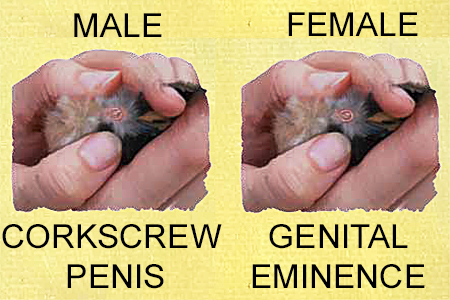
Male and female waterfowl of the same breed and variety are difficult to tell apart until they are several weeks old. Except for a few autosex breeds of geese, the only way to determine the gender of waterfowl hatchlings is by vent sexing. Happily that is not nearly as difficult as it is for chickens and other land fowl.
Sexing Ducklings
As ducklings grow, darker bills may distinguish the females of nonwhite varieties. Mallard hens and others of similar color have brown and orange bills, compared to the males’ greenish bills. As the ducklings feather out, the head and back feathers of Mallard-colored hens are not as dark as those of the drakes (male ducks).
As ducks mature, the female’s call becomes a loud quack, while the male’s call becomes a hoarse whisper. At about the same time the drakes lose their voices, they also develop conspicuous drake feathers that curl up and forward at the top of the tail. Among Muscovies, the drakes are much larger than the hens.
Sexing Goslings
Distinguishing a male from a female gosling is tricky, except for the autosex breeds — Pilgrims and Shetlands, and to a limited extent Embdens, Romans, and Sebastopols. Among Pilgrim and Shetland geese, the males and females maintain two different plumage colors throughout their lives. The ganders are yellow when young and feather out white, while the hens are gray or gray and white.
Embdens, Romans, and Sebastopols may be sexed with a fair degree of accuracy for only about their first three days of life, when the hens are a darker gray than the ganders. As they grow, both genders are basically all white.
Among African and Chinese geese of about six weeks of age, or sometimes earlier, the head knob of the male becomes noticeably larger than that of the female. Into maturity, the head knob remains the distinguishing feature by which the genders may be told apart.
For goose breeds that are neither autosex nor knobbed, male and female goslings can be difficult to tell apart. With experience, you might learn to recognize subtle differences in their voices and body posture.
Vent Sexing Waterfowl
Vent sexing is the only reliable way to sex non-autosex waterfowl hatchlings. However, it requires lots of practice, as well as extreme care to avoid injuring delicate parts.
Having an experienced person show you how to do it is the best way to learn. Barring that, practice on ducklings or goslings that are a couple of weeks old. That way you can learn with less chance of injuring the older birds and a better chance of seeing what you’re looking for.
The purpose of vent sexing is to detect the presence or absence of a penis in the cloaca just inside a bird’s vent. Because the organ is so tiny, you need a strong light and good eyesight, or a good desktop magnifying glass with a built-in light.
Understandably, the little fellas can be reluctant to show you theirs. So just because a penis doesn’t pop out does not automatically mean the bird is a female. You need to peer into the everted cloaca to ascertain whether or not a penis is actually in there. Here are the steps for vent sexing a duckling or gosling:
- Gently pick up one bird and turn it upside down so you can see the vent easily.
- Bend the tail toward the bird’s back, out of the way. Don’t be surprised if a little bit of poop squirts out.
- With your thumbs, smooth the down away from the vent so you can get a better view.
- Use your thumbs and one index finger to spread the vent to expose the cloaca. Do not squeeze the vent as if it were a pimple.
- If it’s a male, a wormlike penis will corkscrew out. A female has, instead, a rosette of pink tissue known as the genital eminence.
- If you can’t tell for sure after about 30 seconds of manipulation, release the bird to give it a rest, and try again later.
The same technique is used to vent sex mature waterfowl. But because of their larger size, they can be a bit more difficult to handle. And when they squirt, it won’t be a “little bit” of poop!
And that’s today’s news from the Cackle Coop.
Gail Damerow is the author of Hatching and Brooding Your Own Chicks: Chickens, Turkeys, Ducks, Geese, Guinea Fowl

